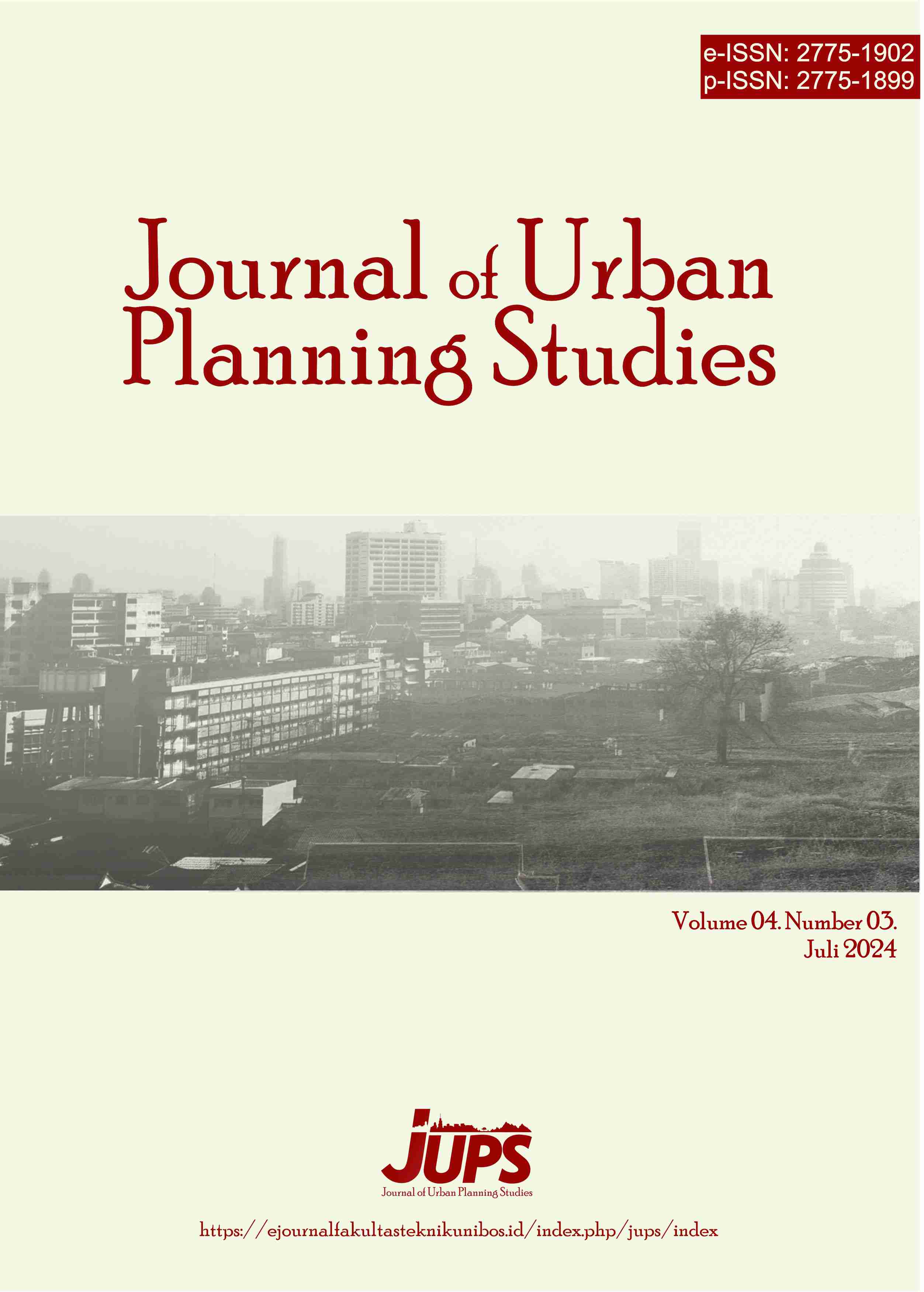Factors that Encourages Residents to Stay in Flood-Prone Areas, Dayeuhkolot Village, Bandung Regency
DOI:
https://doi.org/10.35965/jups.v4i3.530Keywords:
Dayeuhkolot Village, Flood-prone area, Residents endurance factorsAbstract
Dayeuhkolot Village is one of the villages in Bandung Regency that is consistently hit by flood disasters. According to data from the Bandung Regency Disaster Management Agency (BPBD) in 2019, there were a total of 41 flood incidents, primarily occurring during periods of heavy rainfall. The recurrent flooding in Dayeuhkolot Village has resulted in significant losses for the local community. Consequently, some residents of Dayeuhkolot Village have chosen to move out, leading to a decline in population growth in the area. Despite the relocation of some residents, others have chosen to remain in Dayeuhkolot Village despite the constant threat of floods during the rainy season. This research investigates the factors influencing residents' decisions to either stay or move away from Dayeuhkolot Village due to the recurring flood disasters. To determine these factors, this study employs logistic regression analysis with independent variables related to environmental quality, services, social factors, accessibility, economics, job opportunities, and land prices. The research findings indicate that the primary factors influencing the residents of Dayeuhkolot Village's decision to stay or move due to floods are environmental quality and the community's economy. Among these two factors, the variable of environmental quality, which encompasses safety, cleanliness, and environmental health, has the most significant impact on residents' preferences.
References
Budimansyah, R. D. D., & Sofianto, K. (2018). Banjir Dayeuhkolot: Kisah Lama Dalam Cerita Baru. Jurnal Dialog Penanggulangan Bencana, 2087, 128. Retrieved from https://www.academia.edu/download/58575897/jurnal-vol-9-no-2-2018.pdf#page=48
Fox, W. P., & Hammond, J. (2019). Advanced Regression Models: Least Squares, Nonlinear, Poisson and Binary Logistics Regression Using R. In F. P. García Márquez & B. Lev (Eds.), Data Science and Digital Business (pp. 221–262). Cham: Springer International Publishing. doi: 10.1007/978-3-319-95651-0_12
Hailpern, S. M., & Visintainer, P. F. (2003). Odds Ratios and Logistic Regression: Further Examples of their use and Interpretation. The Stata Journal: Promoting Communications on Statistics and Stata, 3(3), 213–225. doi: 10.1177/1536867X0300300301
Hair, J. F. (2009). Multivariate data analysis. Retrieved from https://digitalcommons.kennesaw.edu/facpubs/2925/
Kalesaran, R. C., Mandagi, R. J., & Waney, E. Y. (2013). Analisa Faktor-Faktor Yang Mempengaruhi Keputusan Konsumen Dalam Pemilihan Lokasi Perumahan Di Kota Manado. Jurnal Ilmiah Media Engineering, 3(3). Retrieved from https://ejournal.unsrat.ac.id/index.php/jime/article/view/4278
Kayat, S. C. (2023). Implementasi Kebijakan Bantuan Sosial Bencana Banjir Di Kecamatan Dayeuhkolot Kabupaten Bandung. Jurnal Dialektika Politik, 7(2), 209–221.
Kurniasih, N. (2017). Public health information behavior at flood-prone area in Bandung Regency: A case study in Baleendah Village, Andir Village, Bojongsoang Village and Dayeuh Kolot Village. Retrieved from https://osf.io/y23en/download
Mamangkej, E. B., Tjakra, J., & Sumanti, F. P. (2023). Analisis Faktor-Faktor Yang Mempengaruhi Pemilihan Lokasi Perumahan Di Kota Manado Dan Kabupaten Minahasa Utara. TEKNO, 21(84), 527–538. Retrieved from https://ejournal.unsrat.ac.id/v3/index.php/tekno/article/view/47985
Muhamad, R. T., Sekarningrum, B., & Agma, Y. M. (2017). Modal Sosial Dalam Penanggulangan Bencana Banjir (Kasus Di Kabupaten Bandung, Jawa Barat). Sosioglobal: Jurnal Pemikiran Dan Penelitian Sosiologi, 1(2), 101–114. Retrieved from http://journal.unpad.ac.id/sosioglobal/article/view/13306
Pudjiwidyastuti, A., Setijanti, P., & Ratna, H. (2016). Residential Attributes for Housing Preferences on Suburban Area.“. International Journal of Engineering Research and Technology (IJERT), 5(1), 477–484. Retrieved from https://www.academia.edu/download/63061509/residential-attributes-for-housing-preferences-IJERTV5IS01051620200423-84793-vg0lag.pdf
Putra, B. Z., & Rahayu, S. (2015). Faktor-Faktor Yang Mempengaruhi Pemilihan Perumahan Dan Tipe Rumah Di Perumahan Bukit Emerald. Teknik PWK (Perencanaan Wilayah Kota), 4(4), 681–691. Retrieved from https://ejournal3.undip.ac.id/index.php/pwk/article/view/10077
Rusydi, A., Isya, M., & Darma, Y. (2023). Analisis Faktor–Faktor Yang Mempengaruhi Tidak Berfungsinya Terminal Bireuen. Jurnal Arsip Rekayasa Sipil Dan Perencanaan, 6(1), 41–52. Retrieved from https://jurnal.usk.ac.id/JARSP/article/view/27760
Suripin, S., & Kurniani, D. (2016). Pengaruh Perubahan Iklim terhadap Hidrograf Banjir di Kanal Banjir Timur Kota Semarang. Media Komunikasi Teknik Sipil, 22(2), 119–128. Retrieved from https://ejournal.undip.ac.id/index.php/mkts/article/view/12881
Yunida, R., Kumalawati, R., & Arisanty, D. (2017). Dampak Bencana Banjir Terhadap Kondisi Sosial Ekonomi Masyarakat Di Kecamatan Batu Benawa Kabupaten Hulu Sungai Tengah, Kalimantan Selatan. JPG (Jurnal Pendidikan Geografi), 4(4). Retrieved from https://ppjp.ulm.ac.id/journal/index.php/jpg/article/view/3812
Downloads
Published
How to Cite
Issue
Section
License
Copyright (c) 2024 Nabilla Dina Adharina, Dany Lukmanur Hakim

This work is licensed under a Creative Commons Attribution 4.0 International License.













